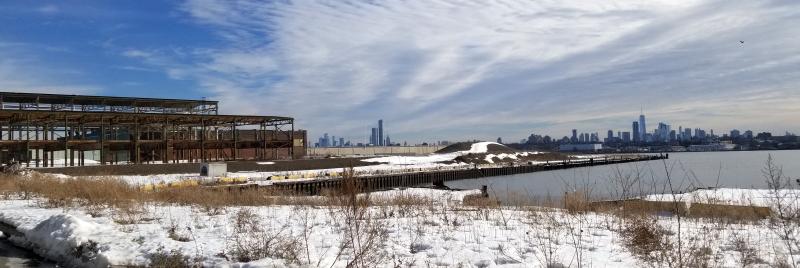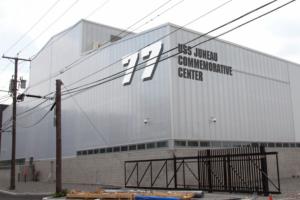
Waiting in line for vaccinations at the site of Federal Shipbuilding. Manhattan skyline in the background.
My wife and I recently received the second of two shots of Covid-19 vaccine at a drive-through vaccination state set up at the USS Juneau Center, on the site of the old Federal Shipbuilding & Drydock Company in Kearny, NJ.
We followed a long line of cars snaking around the scattered warehouses until we reached the garage area where the line split into four lanes with multiple vaccination stations inside the garage doors, that opened to allow cars to enter and leave and then closed again to keep out the cold. We were vaccinated through our open car windows. The process was safe, efficient, and almost painless.
The process was, for me at least, a bit surreal. The long line of cars inching their way around warehouses and past the skeletal remains of a huge fabrication building felt like a cross between waiting for a ride at Disney World and being on the set of a post-apocalyptic zombie movie. I wonder how many of those waiting to be vaccinated knew the history behind the USS Juneau Center or the largely barren industrial space that surrounds it.
The Juneau Center is a rebuilt fabrication building and warehouse in what was once the Federal Shipbuilding & Drydock Company. Built on Kearney Point, a peninsula where the mouth of the Hackensack River meets Newark Bay in the Port of New York and New Jersey, the shipyard operated from 1917 and 1948, building ships primarily for the US Navy during World Wars I and II.
During World War II, Federal set construction speed records. In July 1943, Federal claimed records of 170 days from keel to commissioning on the large destroyer USS Dashiell (DD-659) and 137 days on light destroyer USS Thorn (DD-647). C2 class ships were being built in an average time of 82 days. In July 1943, destroyer escorts were being launched about once a week since spring of 1943. Between the Kearny yard and an associated yard in Newark, Federal launched a company record of 11 ships in 29 days during March 1943.
At its peak, Federal Shipbuilding employed 52,000 people and delivered 350 ships from the yard at Kearny Point. One of those ships was the USS Juneau, an Atlanta class light cruiser, delivered in February 1942. She was sunk by a Japanese torpedo at Guadalcanal in November of that year.
Of the numerous ships sunk at Guadalcanal, the USS Juneau is remembered in particular because of the five Sullivan brothers who died when she was sunk. All five brothers enlisted in the Navy on the condition that they be allowed to serve together. As a result of the Sullivans’ deaths, the U.S. War Department adopted the Sole Survivor Policy.
Wreckage from the USS Juneau was discovered on March 17, 2018, by the expedition crew of Paul Allen’s research vessel (R/V) Petrel.
After Federal Shipbuilding shut down in 1948, the site was used for scrapping ships. Currently, part of the site is used for warehousing. The development firm Hugo Neu also plans on rejuvenating six buildings and creating over 2.5 million square feet of commercial space as small business office space.
The USS Juneau Memorial Center was dedicated in 2013, in the renovated fabrication shop and warehouse where the keel was laid for the USS Juneau in 1942. The Office of Emergency Management command center occupies part of the mezzanine level while the 15,000 square foot garage space is used to give vaccinations. As of last week, the facility had given close to 13,000 shots.


Is it a case of No car, No jab?
At this facility, no car, no jab. There are walk-in facilities in urban canters not too far away. Getting appointments at either type of center is hard because vaccines are in short supply. And yes, equal access to vaccinations is a real concern.